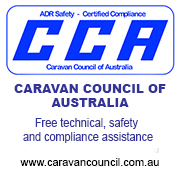'Grossly incorrect ratings and
masses'
Caravan
manufacturers accused of giving
misleading information on plates
  Have your say
Have your say
CARAVAN Council of Australia founder Colin
Young has fired a broadside at RV manufacturers over misleading
information on compliance plates.
The professional engineer claims that up to 90
percent of plates fitted to caravans and camper trailers give false or
incomplete information, particularly when it comes to ratings and masses.
"The main and most serious problem is that
many, for one reason or another, often contain grossly incorrect
information which has significantly contributed to a disturbing number of
problems, complaints and litigation issues," he said.
Misleading tare mass and empty ball-loading
figures were the most common issues.
Mr Young said plates were fitted by
manufacturers to provide an assurance to vehicle registration authorities
and the buyer that the vehicle was fully-compliant with all prescribed
legislation and as such it is ready for use on Australian roads.
"Sadly, for far too many caravans, this is
clearly not the case," he added.
Mr Young has put
together the following article:
Vehicle Safety Standards has stated that all information provided on a
trailer plate must be:
Legible
True
Correct
Accurate
Complete
Actual masses ‒ tare mass and empty ball-loading
‒ must be physically measured by scales or a
weighbridge that is certified, and has been independently checked for
accuracy as prescribed in the licensing contract.
The tare mass and empty ball-loading measurements must be made when the
caravan (including water tanks and gas cylinders) is completely empty and
fitted with all equipment specified on the sales contract.
The legal significance of an assurance needs to be clearly understood.
Negligence, ignorance and assumption are not defences for giving any
information that is not in strict accordance with the requirements.
Stating any information that is fraudulent is ‒
needless to say ‒ a very grave matter.
The trailer plate must show at least the following information:
Manufacturer's name
Caravan model
Vehicle identification number (17-digit)
Date of manufacture (month and year ... example:
08 - 20)
Aggregate trailer mass (ATM) rating
Certification statement: example: This trailer
was manufactured to comply with the Motor Vehicle Standards Act 1989.
The trailer plate may also include additional information, such as that
required for the tyre placard.
Masses and ratings must be stated in kg.
Tyre inflation pressures must be stated in kPa (not psi).
The full specifications of the wheels (diameter, width and profile) and
tyres (diameter, section ratio, width, and type (P/C/LT)
must be stated, so there is no "guessing" required to determine the
complete specifications.
In addition to the information required by VSB1 (Vehicle Standards
Bulletin No 1), it is most prudent to advise
additional information that may very well be deemed to be "information
required by the owner/driver, so as to best ensure the tow vehicle and
caravan are loaded and used in a safe and legal manner".
This information includes the:
Gross trailer mass (GTM) rating
Axle-group rating
Empty ball loading
The gross trailer
mass (GTM) rating is
needed to confirm what braking system is required … is it above or below
2000kg?
The axle-group
rating (AGR) and the
Gross Trailer Mass (GTM) rating are needed for non-load-sharing suspension
systems to confirm if the 120 percent safety factor has been incorporated
in the design of the suspension system.
The empty ball
loading is needed to ensure the caravan is suitable for the
intended tow vehicle, and to assist in correctly loading the caravan so
that load-distribution (in a side view) does not cause any rating to be
exceeded, or the caravan to develop hazardous handling and stability
problems on the road.
It is recommended that the "offset" ‒ plus or
minus "X" mm ‒ of the wheels be added so that if
aftermarket wheels are fitted, the same offset can be selected to avoid
having the sidewalls of tyres foul on any chassis or body component, which
can readily cause dangerous blow-outs.
It is important to know that the allocated GTM rating
has been properly determined by the manufacturer.
Unfortunately, many people continue to use the incorrect "old husband's
tale" ‒ or "equation" ‒
that:
Empty Ball Loading = ATM Rating - GTM Rating or GTM Rating = ATM Rating -
Empty Ball-Loading
This is completely wrong because there is no logical relationship
involved.
The ATM and GTM are fixed ratings … allocated by
the manufacturer in relation to the maximum-permissible "All-Up
and "Axle(s)" limits.
The Empty Ball-Loading is an actual mass that must be measured and is
obviously applicable only to the empty (Tare Mass) condition.
The correct formula is, at any time: Actual Ball Loading = "All-up Mass" -
"Axle(s)-Loading".
It is essential that all caravan buyers fully understand all the
information provided by the manufacturer on the trailer plate before they
accept the caravan so as to avoid possible major problems in the future.
It is most prudent to obtain a copy of the certified measurements of the
Tare Mass and the Empty Ball-Loading.
If you have any questions about any items on the trailer plate, it is
important to have the dealer provide a concise and credible explanation.
BACK TO CARAVANNING NEWS MAIN PAGE
No part of this
publication may be reproduced or transmitted without
the prior written
permission of Dennis Amor.
Copyright 2005
Dennis Amor
All Rights Reserved
|







